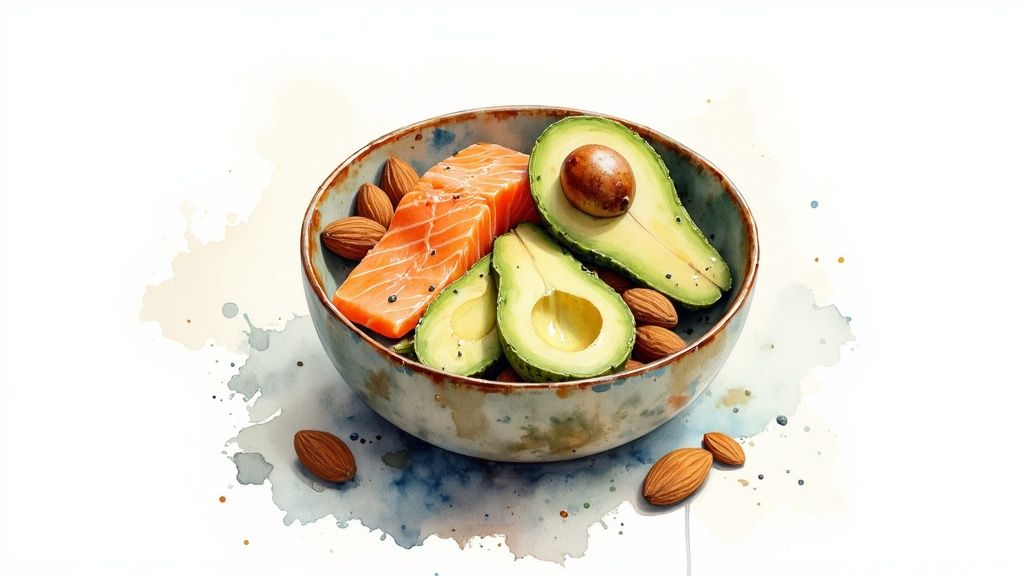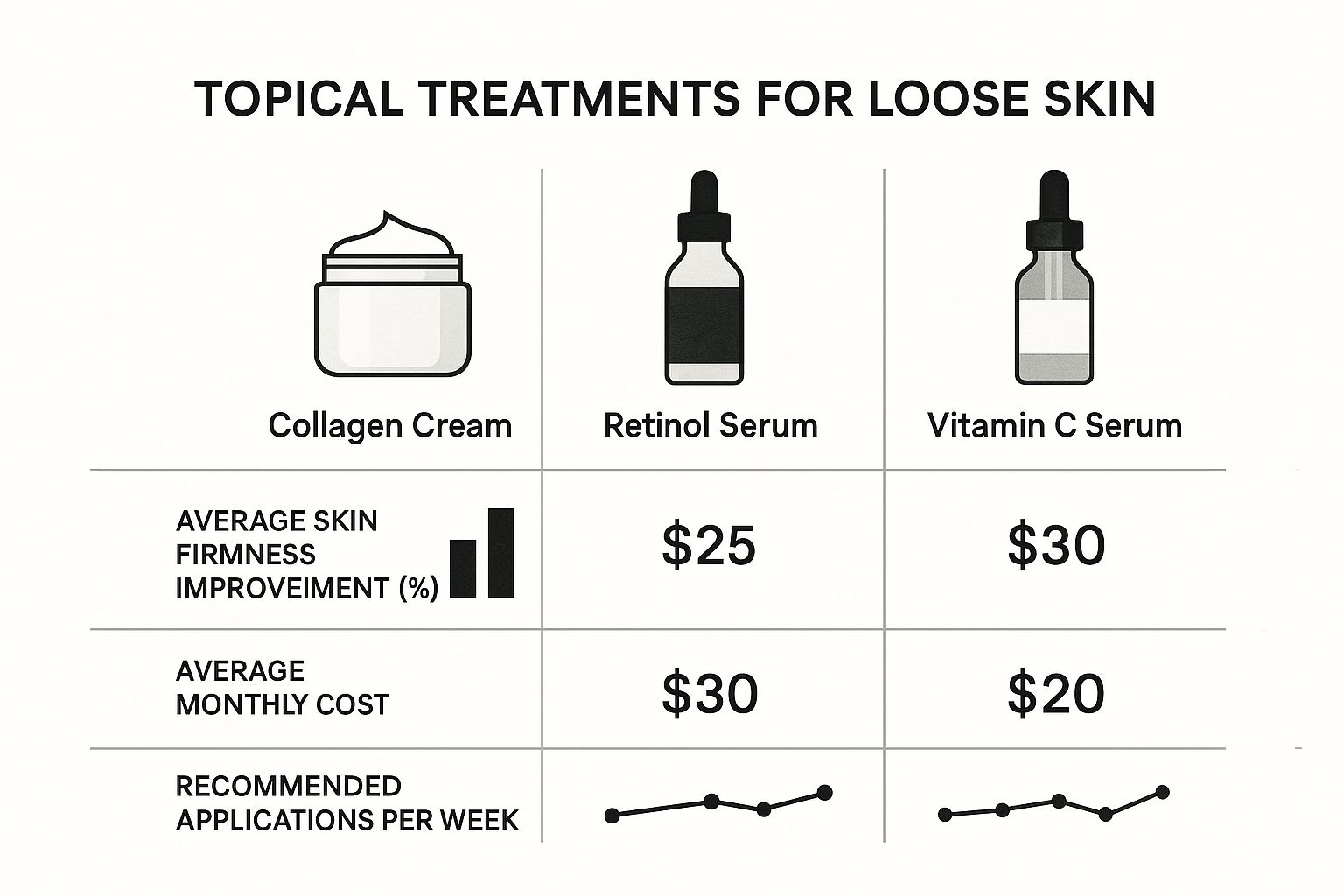
How to Tighten Loose Skin The Ultimate Guide
If you're looking to tighten up loose skin, the best approach is a smart mix of at-home care and professional treatments. The goal is always the same: get your body to ramp up its production of collagen and elastin. These two proteins are the dynamic duo responsible for keeping your skin firm, supple, and resilient.
Why Skin Loses Its Firmness
Before you can fix the problem, you need to understand what’s causing it. I like to think of the skin's structure as a brand-new mattress. Collagen is the firm, supportive core, and elastin provides that amazing spring-back quality. As we get older or go through major life changes, the production of these proteins slows down, and the existing ones start to break down. The result? That once-firm "mattress" begins to sag.
It’s rarely just one thing, either. Several factors usually team up to cause skin laxity. The natural aging process is the biggest one, of course; our bodies just don't make collagen like they used to. But other life events can really speed things up.
Key Causes of Loose Skin and Their Impact
To get a clearer picture, let's break down the primary culprits behind loose skin and see how they affect different parts of the body. Pinpointing the cause can help you choose a more effective treatment plan.
| Cause | Primary Impact on Skin | Commonly Affected Areas |
|---|---|---|
| Aging | Natural decline in collagen and elastin production over time. | Face, neck, arms, hands |
| Significant Weight Loss | Collagen and elastin fibers are damaged from being overstretched. | Abdomen, arms, thighs, buttocks |
| Pregnancy | Rapid, significant stretching of the skin, particularly in the abdomen. | Stomach, breasts, hips |
| Sun Exposure (UV Damage) | UV rays actively break down existing collagen and inhibit new production. | Face, neck, chest, arms, hands |
| Genetics | Some individuals are naturally predisposed to lower skin elasticity. | Can affect all areas of the body |
Each of these factors contributes in its own way, but the underlying issue is almost always a breakdown in your skin's supportive matrix.
The Impact of Lifestyle and Life Events
Think about what happens after significant weight loss. Your skin has been stretched for a long time, and those crucial collagen and elastin fibers can get damaged. When the volume underneath is gone, the skin struggles to snap back to its original shape. Pregnancy does something very similar, stretching the abdominal skin to its limits and often leaving it lax postpartum.
And then there's the sun. It’s probably the biggest external enemy of firm skin. UV radiation doesn't just cause wrinkles and dark spots; it actively destroys your existing collagen and slows down the creation of new fibers. On top of all that, genetics play a role. Some of us are just born with skin that’s less resilient than others.
If you want to dive deeper into boosting your skin's natural scaffolding, our guide on how to stimulate collagen is packed with actionable strategies.
The demand for real solutions is undeniable. The global skin tightening market is booming, reflecting a widespread desire for effective, non-invasive procedures to restore a more youthful appearance.
The Growing Demand for Solutions
This huge interest has been a game-changer, pushing incredible advancements in aesthetic technology. Just look at the numbers: the skin tightening market was valued at around USD 872.04 million in 2024 and is expected to soar to USD 2.76 billion by 2034.
That's a projected growth rate of 12.20% every year, which tells you just how many people are looking for answers. You can read more in this skin tightening market analysis. By understanding what’s causing your skin to lose firmness—whether it's aging, sun damage, or something else—you're in a much better position to choose the right solution from the ever-growing options out there.
Building a Skin Firming Routine at Home

While professional treatments can deliver impressive results, what you do every day at home is the bedrock of your success. This is where consistency truly pays off. The goal is to move past generic advice and build a routine around ingredients and techniques that are actually proven to improve skin elasticity. It’s all about being intentional with your choices.
The market for these products is absolutely huge. To give you an idea, the global demand for skin tightening products hit an estimated USD 718.7 million in 2023. That’s a lot of people searching for solutions. You can explore more skin tightening product insights on grandviewresearch.com to see the full scope. The upside of this massive demand is that it fuels real innovation, giving us access to some seriously powerful ingredients.
Powerhouse Ingredients for Firmer Skin
The first step in building a potent at-home routine is knowing which active ingredients to look for. Think of these as your skin's personal trainers, signaling it to kick collagen and elastin production into high gear. Not everything on the shelf works, so you need to focus on the ones backed by real science.
A few non-negotiables in my book are:
- Retinoids (Vitamin A): This is the undisputed champion. Retinoids speed up cell turnover and directly tell your skin to make more collagen, rebuilding its foundational structure from the inside out.
- Vitamin C: An absolute must-have. This antioxidant not only shields your existing collagen from damage but is also a critical building block for creating new collagen. As a bonus, it leaves your skin looking brighter.
- Hyaluronic Acid: While it doesn't build new collagen, hyaluronic acid is a hydration hero. It pulls moisture into the skin, plumping it up and making it look fuller, which immediately helps with the appearance of sagging.
- Peptides: These are clever little messengers made of amino acids. They signal your skin cells to get busy producing more collagen and work beautifully alongside other firming ingredients.
Figuring out how to layer all these can feel a bit daunting. For a complete walkthrough, our guide on how to build a skincare routine breaks it all down step-by-step.
Beyond Creams and Serums
A truly effective routine doesn't just stop at what you put on your skin. Adding some form of physical stimulation can really amplify the effects of your products and play a big role in tightening things up.
Pro Tip: Consistency trumps intensity. You'll see far better results from a few minutes of facial massage every single day than from one long, aggressive session once a month.
Take facial massage, for example. It’s simple, free, and incredibly effective. Using your knuckles or a gua sha tool, gentle upward strokes help boost circulation, which brings more oxygen and nutrients to your skin cells. This simple act reduces puffiness and gives a nice, temporary lift.
At-home microcurrent devices have also become a popular tool in the skincare arsenal. These gadgets use gentle, low-level electrical currents to stimulate the facial muscles, which in turn encourages collagen and elastin to perk up. They aren't as strong as the machines in a professional's office, but with regular use, they can absolutely offer a gradual toning effect that complements the rest of your routine.
What You Eat and How You Move Matters for Your Skin

Creams, serums, and in-office procedures all tackle skin laxity from the outside. But what you do every single day—what you eat and how you move—builds firm, healthy skin from the inside out. Trying to tighten loose skin without paying attention to your diet and exercise is like building a house on a shaky foundation. It just won't hold up.
Think about it: after major weight loss or a pregnancy, your skin has been stretched. It needs internal support to bounce back. This is where a holistic approach really pays off. You can seriously boost the results of any treatment by giving your body the right fuel and engaging in the right kind of exercise. It's a powerful one-two punch.
Feed Your Skin With Collagen-Friendly Foods
Your skin is in a constant state of repair and regeneration. To build strong collagen and elastin fibers—the very things that keep it firm—it needs specific raw materials. The good news is, you can get them directly from your plate.
The goal is to stock your body's "collagen factory" with everything it needs for top-tier production. Here are some of the heavy hitters to add to your grocery list:
- Protein-Packed Foods: Lean chicken, fish, eggs, and beans are full of amino acids like glycine and proline, which are the literal building blocks of collagen.
- Vitamin C Powerhouses: Don't skip the citrus fruits, bell peppers, strawberries, and broccoli. They're bursting with Vitamin C, a critical antioxidant your body must have for collagen synthesis. The process simply can't happen without it.
- Healthy Fats: Foods like avocados, nuts, seeds, and olive oil deliver healthy fats and Vitamin E. These protect your skin's cell membranes, keeping it hydrated and supple.
On the flip side, a diet loaded with sugar and processed junk will actively work against you. Sugar molecules can trigger a nasty process called glycation, where they attach to collagen fibers and make them stiff and brittle. This essentially sabotages your skin's support structure, leading to more sagging.
A simple but often overlooked factor is hydration. Well-hydrated skin is plumper, more resilient, and has a much better ability to bounce back. Just sipping water consistently throughout the day is one of the easiest and most effective things you can do for your skin.
Build a Tighter Canvas With Strength Training
Exercise is fantastic for your health, but when your goal is to tighten loose skin, not all workouts are created equal. While cardio is great for your heart, strength training is your secret weapon for a firmer, more toned appearance.
When you lift weights or do bodyweight exercises, you build lean muscle. This muscle tissue sits directly beneath your skin, creating a supportive layer that helps fill out any slack. It literally smooths things out from underneath.
For instance, if you're dealing with loose skin on your stomach after having a baby, building a stronger core with moves like planks and leg raises can make a huge visual impact. In the same way, targeting your triceps and biceps can help firm up the skin on your arms. You're not getting rid of the skin itself, but you are building a stronger, tighter structure beneath it to dramatically improve how it looks.
So you've been consistent with your skincare routine and healthy habits, but you're just not seeing the firmness you're after. That’s a pretty common story. When at-home efforts hit a plateau, it might be the right time to look at what professional treatments can do.
These procedures go far beyond what creams and serums can accomplish, using sophisticated technology to wake up your body’s own collagen and elastin production. The results? More dramatic, longer-lasting firmness.
It’s no surprise that the demand for these kinds of treatments is booming. The non-invasive aesthetics market is expected to skyrocket from about USD 73.96 billion in 2024 to an incredible USD 238.04 billion by 2034. That massive growth just shows how many of us are looking for real solutions to tighten loose skin without the downtime and risks of surgery.
The Power Players: Radiofrequency and Ultrasound
When it comes to non-surgical skin tightening, two technologies really dominate the conversation: radiofrequency (RF) and ultrasound. They both have the same end goal—tighter, firmer skin—but they take slightly different routes to get there.
- Radiofrequency (RF) Treatments: Think of RF devices like Thermage as a way to deliver controlled, gentle heat deep into your skin. This heat immediately causes the existing collagen fibers to contract, which can give you a subtle, instant lift. But the real magic happens over time as this process kicks off a natural healing response, prompting your body to build fresh, new collagen.
- Ultrasound Therapy: Treatments like Ultherapy use focused ultrasound energy to penetrate even deeper than RF, right down to the skin's foundational layers. It’s incredibly precise, delivering targeted heat that triggers significant collagen production for a powerful lift that develops gradually over a few months.
One of the biggest draws for both of these is the minimal, if any, downtime. You can often get a treatment and go right back to your day.
The single most important step you can take is scheduling a consultation with a board-certified dermatologist or plastic surgeon. They have the expertise to evaluate your skin’s laxity and unique needs, helping you choose the treatment that will actually deliver the results you want.
This chart gives a great visual of how topical treatments stack up against professional options, which helps explain why many people eventually decide to invest in a procedure for more meaningful change.

As you can see, while a good serum is a fantastic part of any routine, achieving that next level of firmness often means calling in the pros.
Comparison of Top Non-Invasive Skin Tightening Treatments
With a few great options on the table, it can be tough to know which one is right for you. This quick-reference table breaks down the most popular professional treatments to help you compare them at a glance.
| Treatment Type | How It Works | Best For | Average Downtime |
|---|---|---|---|
| Radiofrequency (RF) | Uses radio waves to heat the deep skin layers, stimulating collagen production. | Mild to moderate skin laxity, fine lines, and overall skin rejuvenation. | None to 24 hours (mild redness). |
| Ultrasound (Ultherapy) | Delivers focused ultrasound energy to the skin's foundational layer for deep collagen stimulation. | Moderate laxity, particularly for lifting the brows, neck, and under the chin. | None to a few days of slight swelling or tenderness. |
| RF Microneedling | Combines microneedling with RF energy delivered deep into the dermis via tiny needles. | Skin laxity, textural issues, acne scars, and enlarged pores. | 2-5 days of redness and minor swelling. |
| Fractional Laser | Creates microscopic thermal zones in the skin to trigger a robust healing and collagen-building response. | Laxity combined with surface concerns like sun damage, wrinkles, and uneven texture. | 3-7 days of redness and peeling, depending on intensity. |
Remember, the "best" treatment is always the one that's best for you. A thorough consultation is key to making the right choice.
Next-Level Options: Lasers and Microneedling
Beyond the big two, other fantastic treatments work by creating controlled micro-injuries in the skin. This might sound intimidating, but it's actually a brilliant way to trick your skin into launching a powerful regenerative response. These are great not just for tightening, but for smoothing out your overall skin texture, too.
A real crowd-pleaser is Radiofrequency Microneedling. This treatment is exactly what it sounds like: it uses ultra-fine needles to create tiny channels in the skin while simultaneously delivering RF heat directly into the dermis. This one-two punch is incredibly effective at boosting collagen and elastin, making it a go-to for firming the skin, softening wrinkles, and even improving old acne scars.
Then you have Laser Treatments, like fractional lasers. These work by creating thousands of microscopic treatment zones, leaving the surrounding skin untouched. This "fractional" approach allows the skin to heal much faster, all while stimulating a powerful collagen-remodeling process. It’s an excellent choice if you're dealing with loose skin along with other issues like sun damage or an uneven complexion.
Keep in mind that these procedures aren't a one-and-done deal; you'll likely need a series of sessions to achieve your final goal. To see how they fit into a complete anti-aging plan, take a look at our guide to the best facial treatments for aging skin. Ultimately, the right professional path is a personal decision based on your skin, your budget, and what you hope to achieve.
Maintaining Your Results for the Long Haul

Getting to the point where you love the look and feel of your firmer skin is a fantastic achievement, but the work doesn't stop once you see results. The real key to making it last is shifting your mindset from a short-term project to a long-term commitment.
Let’s be realistic. At-home care demands consistency day in and day out, and even the most effective professional treatments need occasional tune-ups. It’s a lot like fitness—you can’t expect to work out for six months, get into great shape, and then quit the gym forever while keeping the same results. Your skin requires that same ongoing care and attention.
Creating a Sustainable Maintenance Strategy
The best long-term plan starts with a strong defense. Sun exposure is the biggest culprit when it comes to breaking down all that new, healthy collagen you’ve worked so hard to build. Protecting your skin isn't just a good idea; it's non-negotiable.
Here’s what your daily routine should look like:
- Be Relentless with Sunscreen: This is your number one tool. You need to apply a broad-spectrum sunscreen with an SPF of 30 or higher every single day. No exceptions—even on cloudy days. UV radiation is the fastest way to undo your progress.
- Stick With Your Skincare All-Stars: Don't let those powerhouse products gather dust. Continuing with ingredients like retinoids, vitamin C, and peptides keeps your skin's collagen-building engines running smoothly.
- Live a Skin-Friendly Lifestyle: Keeping your weight stable is a huge factor. Big swings on the scale can stretch the skin all over again, which can compromise the firmness you've gained. A balanced diet and regular exercise are foundational.
Protecting Your Professional Treatment Investment
If you've gone the route of professional treatments like radiofrequency or ultrasound, think of it as giving your skin a massive head start. Now, the goal is to keep that momentum. Your provider will almost certainly recommend a maintenance plan to help you do just that.
Maintenance isn't a sign the treatment failed. It's how you proactively stay ahead of the natural aging process and get the most out of your initial investment.
For most non-invasive procedures, this usually means scheduling a single follow-up session every 12 to 18 months. These periodic treatments give your skin another boost, ensuring collagen and elastin levels stay elevated.
When you combine this smart, long-term professional plan with your daily at-home care, you’re creating a powerful strategy to not only tighten your skin but keep it that way for years.
Answering Your Top Questions About Skin Tightening
When you start looking into how to firm up loose skin, it's natural for a lot of questions to pop up. Everyone wants to know what to expect, how long it'll take, and what actually works. Let's clear up some of the most common queries so you can move forward feeling informed and confident.
Setting realistic expectations is probably the most important part of this whole process. Whether you're all-in on a new at-home routine or looking at professional treatments, understanding the timeline helps you stay patient and committed while your skin does its thing.
How Long Does It Really Take to See Results?
This is the big one, isn't it? The honest answer is: it depends entirely on your approach.
If you’re sticking to an at-home plan with top-notch ingredients like retinoids and peptides, you're playing the long game. With consistent daily use, you might start noticing subtle changes in your skin’s texture and bounce within 3 to 6 months. It’s a marathon, not a sprint, but the payoff is worth it.
Professional treatments like radiofrequency or ultrasound work on a different schedule. You often get a little bit of instant gratification—a slight tightening effect right after the session because the heat causes existing collagen fibers to contract. But the real magic happens over the next 2 to 6 months as your body gets the signal to build brand new, strong collagen from deep within.
Can You Firm Up Stomach Skin Without Surgery?
For mild to moderate looseness, absolutely. You can make a real, visible difference on areas like the stomach without ever seeing a scalpel. The trick is to attack it from multiple angles.
Strength training is a huge piece of the puzzle. Building the abdominal muscles underneath gives the skin a tighter, firmer foundation to sit on. Think of it like putting a well-fitted sheet on a firm mattress versus a lumpy one.
Pair that exercise with a daily skincare routine using firming creams, and you're supporting the skin from the outside in. For an even bigger boost, non-invasive treatments like radiofrequency can really tighten things up. Just keep in mind, for significant amounts of excess skin—often after major weight loss—surgery is still the most direct and effective solution.
Are Collagen Supplements Actually Worth It?
The research here is getting more and more promising. A growing body of evidence shows that taking hydrolyzed collagen peptides can genuinely improve skin hydration and elasticity. The idea is that you’re giving your body the exact amino acid building blocks it needs to fire up its own collagen-making machinery.
A quality collagen supplement isn't a magic pill, but it can be a fantastic supporting player in your overall skin-firming strategy. It’s about nourishing your skin’s structure from the inside out.
When you combine a daily supplement with a healthy diet, religious sun protection, and a solid skincare routine, you’re creating an environment where your skin can truly thrive and rebuild.
What's the Single Best Skincare Ingredient for Firming?
If I had to pick just one, it would be retinol. As a vitamin A derivative, it's been the gold standard for decades, backed by a mountain of research. Retinol works by speeding up cell turnover and, most importantly, directly telling your skin cells to produce more collagen. It gets right to the root of the problem.
Of course, a team of ingredients is always better than a single hero. A couple of other powerhouses you should have in your routine are:
- Vitamin C: This powerful antioxidant is essential for the collagen-building process itself. It also protects the collagen you already have from breaking down.
- Peptides: Think of these as little messengers that signal your skin to get busy making new collagen.
The most effective skincare plan will almost always use a combination of these ingredients. By hitting the problem from different angles, you give your skin the comprehensive support it needs to look and feel firmer.
At Olive Skin Therapy, we create personalized treatment plans to address your unique skin concerns. Book a consultation today to discover how our expert-led services can help you achieve your skin goals.
